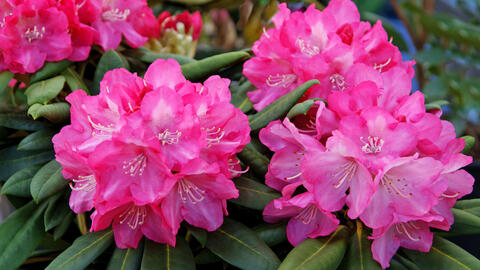How to Prune Old Rhododendrons
Rhododendrons do not usually need trimming. Bare shrubs will appear compact and dense again after rejuvenation with garden shears.

In optimum conditions, Rhododendrons like the ‘Fantastica’ variety do not need pruning. However, hard pruning can help revive bare shrubs.
Pruning is a step that is not absolutely necessary when caring for Rhododendrons, but it can be useful. With the right care, the slow-growing evergreen shrubs will delight garden owners with their beautiful flowers for decades. If your Rhododendron has become too big and is very bare at the bottom, you can simply prune it heavily to get it back into shape. It’s best to prune in February, March or between July and November. All species and varieties can be pruned – even slow-growing Japanese azaleas.
You can prune your Rhododendrons in February, March or between July and November. Rejuvenation pruning is recommended if the Rhododendron is firmly rooted in the ground: trim the stems and branches to a length of 12 to 20 inches. Pruning is less damaging if you spread it over two years.
Many amateur gardeners do not have the heart for pruning heavily, because they simply do not trust the slightly sensitive evergreen flowering shrub to recover from it. And unfortunately, they are sometimes right: it is very important that you check that your Rhododendron is properly rooted before pruning. With unfavorable soil conditions, it’s often the case that the plants sit in the flower bed for years with no significant growth, and slowly go bare at the bottom, but still have green leaves at the shoot tips. It is generally quite easy to lift these shrubs out of the ground with their root ball, because even after several years, they are barely rooted in the surrounding soil. As a result, even after hard pruning, you are generally unable to develop the necessary root pressure for the old wood to form new shoots.
On the other hand, if the plant has grown well over the years and is firmly rooted in the ground, there is nothing against a hard rejuvenation prune. It’s very easy: drastically cut the stems and branches of your Rhododendron to a length of 12 to 20 inches. Dormant buds are found on the woody shoots. These buds form after pruning and develop into shoots again. For older plants, you can use a pruning saw to even trim branches that are as thick as your arm – these stumps also produce new shoots.
If you don’t trust yourself to prune your Rhododendron all at once, you can also do it gradually. Rejuvenation pruning is less damaging to the Rhododendron if you spread it over two years. This way, the shrub does not lose all of its leaves at once. It is therefore best to only prune around half of the branches in the first year. The pruning cuts will already be covered by new growth when you trim the remaining long branches the following year. You should use a pruning knife to make clean cuts to the edges of the large wounds made by the saw and treat them with a wound dressing product.
After pruning, Rhododendrons need a little more care to get back to full health. This includes a good supply of nutrients with horn shavings or a special Rhododendron fertilizer, a new layer of mulch and plenty of lime-free water during dry periods – ideally from a rain barrel. Important: do not transplant the Rhododendron in the first two years after pruning, otherwise there is a risk that it will not grow new shoots.

Give your Rhododendron enough time to rebuild its crown. Despite the hard pruning, the evergreen shrub will not grow much faster than before. After rejuvenation, it can take four years for the crown to look reasonably attractive again and for the Rhododendron to form new buds. Each spring in the years after pruning, ideally by the end of February, use garden shears to trim all long and unbranched new shoots so that the crown can become dense and compact again.



